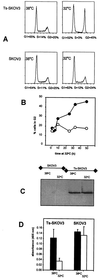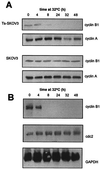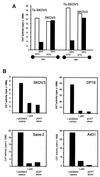p53 regulates a G2 checkpoint through cyclin B1
- PMID: 10051609
- PMCID: PMC26751
- DOI: 10.1073/pnas.96.5.2147
p53 regulates a G2 checkpoint through cyclin B1
Abstract
The p53 tumor suppressor controls multiple cell cycle checkpoints regulating the mammalian response to DNA damage. To identify the mechanism by which p53 regulates G2, we have derived a human ovarian cell that undergoes p53-dependent G2 arrest at 32 degrees C. We have found that p53 prevents G2/M transition by decreasing intracellular levels of cyclin B1 protein and attenuating the activity of the cyclin B1 promoter. Cyclin B1 is the regulatory subunit of the cdc2 kinase and is a protein required for mitotic initiation. The ability of p53 to control mitotic initiation by regulating intracellular cyclin B1 levels suggests that the cyclin B-dependent G2 checkpoint has a role in preventing neoplastic transformation.
Figures





References
-
- Fearon E R, Vogelstein B. Cell. 1990;61:759–767. - PubMed
-
- Donehower L A, Harvey M, Slagle B L, McArthur M J, Montgomery C A J, Butel J S, Bradley A. Nature (London) 1992;356:215–221. - PubMed
-
- Lee J M, Abrahamson J L, Kandel R, Donehower L A, Bernstein A. Oncogene. 1994;9:3731–3736. - PubMed
-
- Farmer G, Bargonetti J, Zhu H, Friedman P, Prywes R, Prives C. Nature (London) 1992;358:83–86. - PubMed
-
- Mack D H, Vartikar J, Pipas J M, Laimins L A. Nature (London) 1993;363:281–283. - PubMed
Publication types
MeSH terms
Substances
LinkOut - more resources
Full Text Sources
Other Literature Sources
Research Materials
Miscellaneous

